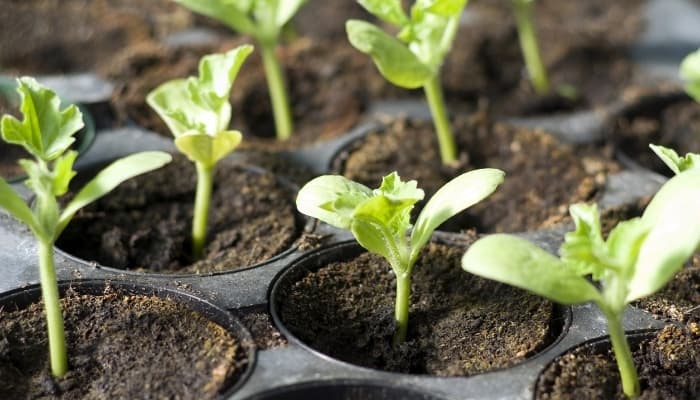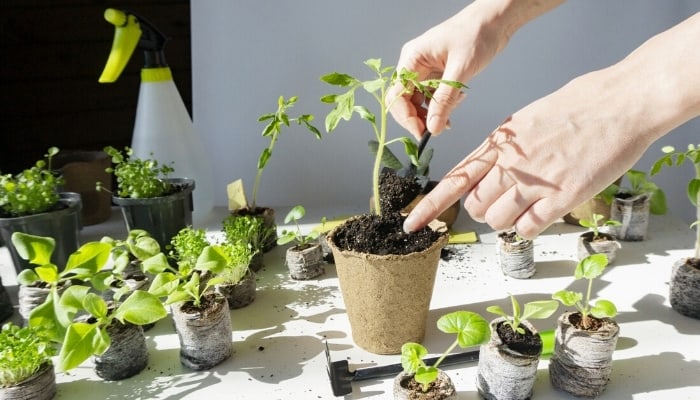The initial stage of growth after sprouting is crucial for the survival of seedlings. During this time, they either develop strong and healthy or the roots perish, resulting in the premature death of the seedlings.
Most of the time you won’t know what’s happening under the surface, but then the seedlings turn yellow, and you have to figure out why and what to do about it.
Why are my seedlings turning yellow? Root damage is the main reason seedlings turn yellow. Either the soil is wet or there’s nitrogen deficiency, which causes chlorosis or yellowing seedlings. Other reasons include inadequate light, irregular watering, compact soil, the wrong pH levels, pests or diseases, or nutrient deficiency.
Most of the time, the causes of seedlings turning yellow are environmental and can be managed. It’s important to provide the ideal growing conditions for sensitive seedlings.
Read more to find out what to do about seedlings turning yellow.
9 Reasons for Seedlings Turning Yellow
Seedlings are like toddlers; they’re prone to falling ill at the slightest change in the conditions around them.
Much like with toddlers, you need to take care of your seedlings and provide them with the ideal growing conditions that suit each species.
If and when they do turn yellow, look for one or more of the reasons below.
1. Cotyledons No Longer Needed
Cotyledons are the first “leaves” to emerge on a newly sprouted seedling.
They are not considered true leaves, but they play an important role in delivering nutrients to the plant and getting photosynthesis started.
This is critical for the survival of the seedling while the roots are still not ready to absorb moisture and nutrients in the soil.
Once the true leaves emerge and grow large enough to complete photosynthesis, the cotyledons will turn yellow and eventually fall off. This is completely normal and is no cause for concern.
2. Not Enough Light
Not all plants can tolerate partial shade or dim light. If the seedling needs bright light whether it’s from direct sunlight or filtered light, then planting it in a shady spot will cause it to turn yellow.
Before you choose the right spot for the seedling, consult the instructions that come with it or ask the person who sold it to you about the right light conditions for this specific species.
If you’re using artificial light to replace the natural light, that could be the reason the seedling is turning yellow. Look for an adequate grow lamp that provides light similar to the sun.
This full-spectrum dual-arm lamp is ideal, and you can use it for several seedling trays simultaneously.
3. Too Much Light
Even if the mature plant needs full sun, that doesn’t mean that the seedlings also needs lots of light to grow.
Remember that seedlings are fragile with an underdeveloped root ball and few leaves for photosynthesis.
Shading the seedlings during the hottest part of the day is a good idea to protect them from the glare of the sun.
4. Too Much Water
Soggy soil is the bane of many seedlings. Unless the plant likes to sit in waterlogged soil (which is rare), you should make sure that the soil drains well and that it doesn’t stay wet for long hours.
Wet soil promotes root rot, which, in the case of seedlings, can prove to be fatal.
5. Lack of Water
Getting the right amount of water to the seedlings is a crucial task. While overwatering can damage the roots, not providing enough water will also lead to the demise of the seedlings.
Dry soil means all the nutrients are not accessible to the roots of the seedlings. Without nutrients and moisture, the seedlings turn yellow.
6. Too Much Fertilizer Too Soon
Fertilizer is important for many seedlings to trigger new growth and help them fight off diseases, but not all seedlings need fertilizer immediately after planting.
The fertilizer can cause root burn or the seedling will be stressed with the fast growth spurt.
7. Needs Fertilizer
Lack of nutrients in the soil can be a decisive factor in the success or failure of the seedlings when they are ready for transplanting.
Without nutrients, the seedlings cannot support the growth of the stems and leaves.
The leaves turn yellow, the seedlings wilt, and they eventually die. Test the soil before transplanting, and provide food supplements or slow-release organic fertilizer to support the seedling.
8. Time To Transplant
Some seedlings have a specific time to plant or transplant them. If you get the timing wrong, the seedlings will wilt and turn yellow.
For example, a seedling that needs moderate temperatures has to be transplanted in the early spring once the weather warms up or in the early fall.
If you delay the transplant time by a few weeks, the seedling would face excessive heat that could stunt its growth and cause it to turn yellow.
Also, seedlings in tiny containers will quickly run out of room and deplete their limited soil of nutrients. Don’t delay transplanting when the time comes.
9. Diseases
Diseases are another culprit behind seedlings turning yellow. Infections such as root rot and crown rot cause discoloration of the roots.
Unless you step in quickly and treat the disease with the right fungicide, the seedling might not survive.

Should I Remove Yellow Leaves?
Yellow leaves are no longer functional, and if they’re caused by diseases, they can spread the disease to healthy leaves.
You should pinch or trim the yellow leaves to conserve the seedling’s resources and prevent the spread of the infection to the rest of the plant.
Cutting the sick leaves will also trigger the seedling to grow new healthy leaves in their place.
Can Yellow Seedlings Recover?
The recovery of yellow seedlings depends on the cause of the problem and how fast your intervention was.
For seedlings turning yellow because of inadequate lighting, lack of watering, or poor soil, then stepping in quickly to remedy the situation with proper light conditions, regular watering, or a dose of organic fertilizer respectively would help the yellow seedling recover.
However, if the cause of the issue is something serious, such as a viral infection or damage to the roots, then the seedling might perish, and you would have to start a new plant.
How To Fix Yellow Seedlings
Before you set out to fix yellow seedlings, you need to know the main cause or causes behind the seedlings turning yellow. Once you have put your finger on the issues, you can fix them.
As we have seen, most of the causes of yellow seedlings have to do with the growing conditions. So that’s a good starting point.
You can try one or more of the following solutions to fix the problem:
- Fix Soil pH: Check the soil pH, and make sure the reading you get is within the range suitable for the species of the seedling. While most plants prefer either neutral or slightly acidic soil, some need alkaline soil. Amend the soil accordingly to fix the yellow seedling problem.
- Provide Adequate Lighting: Make sure the plant is getting the right light it needs. In the absence of the sun, use grow lamps that mimic sunlight.
- Regular Watering: Check the soil before you water the seedling. If the soil is moist, don’t water it, and check that the soil is well drained. Don’t let the soil dry out completely between irrigations. For most seedlings, the top 1 inch of soil should be dry before you water it.
- Fertilizer: Test the soil to find out what nutrients are missing that could cause the seedling to turn yellow. Use plant food supplements and organic fertilizer to enrich the soil.
Related Questions:
Why Are My Seedlings Leggy?
When a plant that requires bright light isn’t getting enough light, it stretches its stems in search of sources of light for the leaves to photosynthesize.
This causes the stems to grow thin and the seedling to become leggy. Providing enough light will fix this problem and the seedling will have a normal growth rate as the stems thicken.
Why Are My Seedlings Falling Over?
If the seedlings start to fall over each other immediately after sprouting, this could be caused by bacterial seedling blight.
The problem with this disease is that it spreads too fast for you to intervene in time and try to save the seedlings.
Another cause for seedlings falling over is when they become leggy from lack of light. The top-heavy seedlings with thin stems fall to the ground easily. Use grow lamps to fix this problem.
Conclusion
Seedlings turning yellow is a problem that has to do with inadequate light conditions, poor or compact soil, irregular watering, or pests and diseases.
Fixing this problem involves looking for the cause of the problem and fixing it to help the seedling grow healthy and strong.

